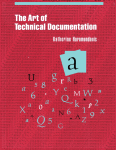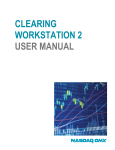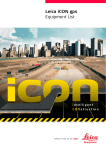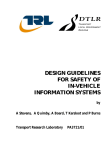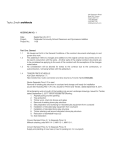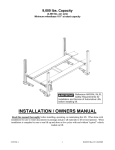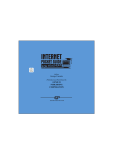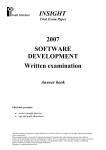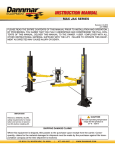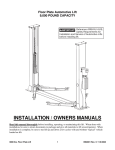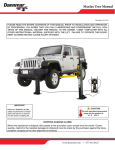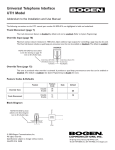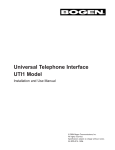Download Software Documentation - Genium Publishing Corporation
Transcript
DRAFTING MANUAL Update 58 Update By: R.L.58Homkes* 1.0 GENERAL Standard(s) or publication(s): Software is now an integral part of the design, development, and manufacturing of our products. It is also an integral part of many of the products themselves since embedded controllers are used in an increasing number of applications. Because of the importance of software, it must be treated as another form of engineering, not as an add-on to the electromechanical area. This means that the standard development and documentation processes that are used for hardware must also be used for software. The adherence to certain common development standards documents that the software is being developed in a consistent and predictable manner. Initial impetus for using a certain standard may come from the desire to receive certification (e.g. ISO-9000) or to meet bid specifications for a particular contract (e.g., a DOD contract). A more important reason for standards, including documentation standards, is to provide a common basis of understanding and communication between the developers and the acquirers of software. This understanding should result in quicker agreements on specifications, fewer change orders, and the production of better quality software. A standard process of development and documentation will also help the software development organization itself. When dealing with embedded controllers, concurrent engineering can only occur if the mechanical, electrical, computer and manufacturing engineering areas are involved from the beginning of the product development process. Systems engineering must properly partition the product functionality among mechanical, electrical, and computer components. This partitioning must be documented so that the development team knows the boundary of each specialty. This, in turn, helps during product testing when determining whether a certain problem is hardware or software related. Thus all software, whether it is of the embedded controller; information systems; or command, control, and communications type, must be documented. 2.0 REFERENCES 2.1 Government Defense Automated Printing Services Building 4 / Section D 700 Robbins Avenue Philadelphia, PA 19111-5094 215-697-2000 http://www.dodssp.daps.mil/ * Purdue University Kokomo, Indiana Section K19 Page 1 December 1997 Software Documentation MIL-STD-100G, Engineering Drawing Practices (supersedes DOD-STD-100, will probably be superseded by ASME Y14.100) MIL-STD-473, Configuration Management (supersedes MIL-STD-483, will probably be superseded by MILSTD-2549) MIL-STD-498, Software Development and Documentation (will probably be superseded by ISO/IEC IS 12207) 2.2 Industry Electronic Industries Association 2500 Wilson Blvd. Arlington, VA 22201 703-907-7500 http://www.eia.org/ Standard(s) or publication(s): CMB4-1A, Configuration Management Definitions for Digital Computer Programs CMB4-2, Configuration Identification for Digital Computer Programs CMB4-4, Configuration Change Control for Digital Computer Programs Institute of Electrical and Electronics Engineers IEEE Service Center 445 Hoes Lane Piscataway, NJ 08855-1331 800-678-4333 http://standards.ieee.org/index.html Standard(s) or publication(s): IEEE Std 610.12, Glossary of Software Engineering Terminology IEEE Std 828, Standard for Software Configuration Management Plans IEEE Std 829, Standard for Software Test Documentation IEEE Std 1042, Guide for Software Configuration Management IEEE Std 1063, Standard for User Documentation IEEE Std 1074, Standard for Developing Software Life Cycle Processes GENIUM PUBLISHING *Supersedesissue issueofofDecember, July 1985 1982 *Supersedes Section K19 Page 2 December 1997* DRAFTING MANUAL Software Documentation Update 58 2.3 Standards Organizations ance standards — Part 4: Guide to dependability program management American National Standards Institute 11 West 42nd Street New York, NY 10036 212-642-4900 (voice) 212-398-0023 (fax) http://www.ansi.org/ ISO 9001:1994, Quality system model for quality assurance in design, development, production, installation and servicing. ISO 9002:1994, Quality system model for quality assurance in production, installation and servicing. Standard(s) or publication(s): ANSI/ANS 10.3-1995, Documentation of Computer Software ANSI/IEEE 1002-1987 (R1993), Software Engineering Standards, Standard Taxonomy ANSI/IEEE 1063-1989, Software User Documentation ANSI/IEEE 610.12-1990, Standard Glossary of Software Engineering Terminology ANSI/IEEE 829-1983 (R1991), Software Test Documentation ANSI/ISO/ASQC Q9000-3-1991, Quality Management and Quality Assurance Standards -Guidelines for the Application of ANSI/ISO/ASQC 9001 to the Development, Supply and Maintenance of Software Software Engineering Institute Carnegie Mellon University Pittsburgh, PA 15213 412-268-5800 http://www.sei.cmu.edu/ Standard(s) or publication(s): Software Capability Maturity Model, Version 1.1 Systems Capability Maturity Model International Organization of Standards Case Postale 56 CH-1211 Geneva Switzerland http://www.iso.ch ISO 9003:1993, Quality system model for quality assurance in final inspection and test. 2.4 Other Organizations American Society for Quality 611 East Wisconsin Avenue Milwaukee, WI 53202-4606 800-248-1946 or 414-272-8575 http://www.asqc.org/ 3.0 DEFINITIONS 3.1 Algorithm — The ordered set of steps required to complete a task. 3.2 Alpha testing — The first testing of software, usually by software developers, to verify that it is working as designed. Done in a simulated or lab environment. See verification. 3.3 Applications software — Software that processes data for a user. Contrast with systems software. 3.4 Assembler — A program that translates an assembly language program into machine code. Contrast with compiler. 3.5 Baseline — A fixed point in time in the product development process that results from a formal event such as a code review. The baseline is represented by an engineering document or set of documents, which are approved, released, and placed under change control as a result of the event. 3.6 Beta testing — The testing of software, usually by a test user group, that validates the software actually meets customer requirements. See validation. 3.7 CAD — Computer Aided Design. The use of computers to design products. 3.8 CAM — Computer Aided Manufacturing. The use of computers to control the manufacturing of products. 3.9 CIM — Computer Integrated Manufacturing. The Standard(s) or publication(s): ISO 9000-1: 1994, Quality management and quality assurance standards-Part 1: Guidelines for selection and use. ISO 9000-2:1993, Quality management and quality assurance standards-Part 2: Generic guidelines for the application of ISO 9001, ISO 9002 and ISO 9003. ISO 9000-3:1991, Quality management and quality assurance standards-Part 3: Guidelines for the application of ISO 9001 to the development, supply and maintenance of software. ISO 9000-4:1993, Quality management and quality assur*Supersedes *Supersedes issue issue of of December, July 1985 1982 GENIUM PUBLISHING DRAFTING MANUAL Section K19 Page 3 December 1997 Software Documentation Update 58 integration of computers, electrical, and mechanical devices in the design and manufacturing of products. This may also include automated accounting and reporting tasks. See also mechatronics. 3.10 Command, control, and communications software — Software used to control a computer or computer network and assist in the execution of application software. 3.11 Compiler — A program that translates a high level language (e.g. C++) into machine code, usually with an intermediate step at the assembly language level. 3.12 Configuration management — The activities to identify and control software modifications. 3.13 Documentation — Technical data that explain the purpose, design, operation, and maintenance of a product. 3.14 Editor — A program that is used to create and modify a file, generally a text file of program code or program parameters. 3.15 Embedded controller — A microprocessor that is incorporated into a device to control that device. 3.16 Embedded system — Specialized computer system that controls a device. Generally the computer program does both system and application functions and uses some combination of sensors and actuators. 3.17 Firmware — Software that is resident in the ROM (Read Only Memory) of hardware devices. 3.18 Hardware — The physical components of a computer system. 3.19 Library — A collection of computer program products, including software and documentation, which has proper identification, control and backup and is organized for accessibility and reuse. 3.20 Linker — A program that produces executable code from assembled source code files by resolving references between the files. 3.21 Loader — A program that places a linked program into computer memory and prepares it for execution. 3.22 Mechatronics — The synergistic integration of mechanical and electrical components with computer control in the design of products and manufacturing processes. handles a specific task as part of a larger program. It can also be described as the lowest level set of code that can be treated and tested as a unit. 3.26 Object code — The linkable or loadable output from the compilation and assembly of program source code. 3.27 Object-Oriented — An analysis, design, programming, and testing technology that builds systems from reusable components called object classes. 3.28 Program — A set of computer instructions and data that direct the computer to complete a task or tasks. 3.29 Release — A new version or revision of a computer program. 3.30 Revision — A minor upgrade of a computer program or programs to fix errors or enhance program functionality. A new revision does not generally require a new set of documentation. 3.31 Software — The set of computer programs that enables a computer to perform some computational or control function. 3.32 Source code — The set of statements of a computer program that must be assembled or compiled to produce object code. 3.33 Systems software — Software used to control the computer and assist in the execution of application software. A newer term is command, control, and communications software. 3.34 Validation — Testing in a live environment to confirm that the software is working properly. This is also called beta testing and assures that the software meets customer needs and expectations. 3.35 Verification — Testing in a simulated environment to ensure that the software is being developed according to customer specifications. This is also called alpha testing and assures that software operates according to its design. 3.36 Version — An initial release or a major upgrade of a computer program or programs. A new version is unlikely to be compatible with previous versions and will generally require a new set of documentation. Contrast with revision. 3.23 Metrics — A set of measurements of computer software, usually in the areas of quality and productivity. 3.24 Milestone — A checkpoint in the product development process that signifies a major event or accomplishment. 3.25 Module — A self-contained software component that 4.0 PROCESS DOCUMENTATION Because of the importance of quality in our products, many organizations have to certify that their product development GENIUM PUBLISHING *Supersedesissue issueofofDecember, July 1985 1982 *Supersedes Section K19 Page 4 December 1997* DRAFTING MANUAL Software Documentation Update 58 processes are organized to produce a quality product. This certification may include ISO-9000, QS-9000, and/or the Software Engineering Institute Capability Maturity Model. All of these models require a predictable method or process. As Larry Constantine wrote in Software Development (March 1995), “Consistency is the grandfather of quality. It is an axiom of process improvement that before you can improve a process, you have to get it under control - it must be reproducible. As long as the process of software development is ‘chaotic’ there can be no systematic refinement or incremental enhancements.” This means that a development process must be chosen and documented by the organization so that all software projects follow the same process, thus allowing the process to be modified and improved as lessons are learned. No matter which process model (or process model permutation) is chosen, the process documentation is actually the quality system documentation of the organization. Likewise the project documentation is proof that the project is following that quality system. This project documentation will typically include: • Software requirements specifications • Software design specifications • Software development plan • Project timelines and milestones • Development staffing • Test plans • Source code 4.1 Process Methodologies / Models • Testing, measurement, and calibration documentation There are many different process methodologies or models that can be used to develop software. The classic model is the linear sequential or “waterfall” model. In this model the development process works through a number of phases before the software product is delivered to the acquirer. These phases usually include setting requirements specifications, analysis, design, coding and testing. Each phase ends with a checkpoint where a development document is received and reviewed by management before approval to move to the next phase is granted. The problem with this model is that the acquirer of the software may not be able to establish the complete set of specifications on the first try, and will only receive a “view” of the working system much too late for changes to be easily made. • Manufacturing documentation • User manuals and instructions • Configuration management information. A second popular method is “prototyping.” Prototyping uses a “quick and dirty” design and coding method that allows the acquirer to see a model of the new system and respond to it. This response then becomes the updated requirements specification for the project. A problem that may result is that the system prototype may end up influencing the final product more than it should, with inappropriate decisions on design and implementation being incorporated into the final product. A third popular model, the “spiral model,” remedies this problem by using a series of planning, risk analysis, engineering, and acquirer evaluation steps. After each acquirer evaluation step, a new cycle begins. Unfortunately, if not managed well, the spiral model can turn into a seemingly endless loop where final system specifications are never completely determined. Object-oriented technologies generally use this model. Further information on software development processes can be obtained from Software Engineering: A Practitioner’s Approach, by Roger Pressman, or Software Engineering, by Ian Sommerville. Object-oriented technologies can be reviewed in Object-oriented Software Engineering, by I. Jacobson. *Supersedes *Supersedes issue issue of of December, July 1985 1982 5.0 REQUIREMENTS SPECIFICATIONS The requirements specifications are the customer requirements for the product. They usually consist of two parts, a listing of the functionality of the product along with the constraints that the designer/developer must follow. Unfortunately for the developer, requirements specifications usually evolve as the acquirer understands the product better. This means that the developer must respond to Engineering Change Orders (ECO) while the product is being developed. Since the later in the process an ECO is issued, the more expensive the implementation, it is in the best interest of both developer and acquirer to spend more time during the specification phase of the project, thus saving time later in the process. Included in the requirements specifications are: • All processing functions to be performed together with any appropriate timing, tolerances, accuracy’s, etc. • All inputs and outputs in terms of format, units, source/ destination, validation, etc. • Characteristics of the data in terms of definition of elements, units of measurements, ranges, accuracies, precisions, and frequencies • Interfaces with hardware and other software • All design requirements and constraints to be considered with respect to modularity, operation time, storage, etc. For additional specifications preparation guidelines, refer to section K15, paragraph 5. GENIUM PUBLISHING DRAFTING MANUAL Section K19 Page 5 December 1997 Software Documentation Update 58 5.1 Functionality Product functionality is the core of the requirements specification. It is simply what tasks the product is being designed to accomplish and what features the product will have at its disposal to accomplish the tasks. A systems analyst can create models to assist in the understanding of the product requirements. A process model is useful in displaying the functionality of the system. A data model will show data relationships and possibly allow increased efficiencies in data storage and use. Behavioral models will display the stimulus-response characteristics of the system. Use Case is an object-oriented technique that determines the data and the uses of the data. All models have the benefit of allowing the system designer to more fully understand the system. In addition, the models can be used as documentation of the system, as a guide to generate test plans, and as a review document for the customer. Since new products will often consist of mechanical, electrical/ electronic and computer control components, the job of the system engineer to partition the product functionality is very important at this stage. Mechanical, electrical and software engineers must work with the system engineers to fully understand and agree to this division. The resultant requirements specification can then be used as in product design. 5.2 Constraints The constraints placed upon the system are restrictions that the developer must follow during the development process. While it often seems that the due date is the most important constraint, other constraints affect the designers and programmers. Constraints include: • Size. While current software products using a graphical user interface (GUI) often seem to impose no constraint whatsoever on product size, embedded controllers present a very different situation. As the controller is a component of the product, the price of the controller is a very important component of product cost. This can lead to some interesting arguments between product programmers and manufacturing test programmers. While the product programmers are most concerned with putting product functionality in the fewest bytes possible, the manufacturing test programmers desire additional functionality for testing and quality control during manufacturing. Generally, the manufacturing test programmers will lose this argument as no product programmer wishes to be the one that sends in an ECO for a larger microprocessor. • Speed. Another area where there is a huge difference between the customer requirements of normal applica- tions programs and embedded programs. An automotive Anti-lock Brake System (ABS) must repetitively use information from a sensor and activate an actuator at extremely fast speeds. Likewise, a Supplemental Inflatable Restraint (SIR) or air bag system must respond to the deceleration sensor immediately in order to deploy the bag in time to protect the occupant of the automobile. • Robustness and Reliability. One of the goals of any system is that it have the ability to continue processing given a particular unusual situation. This robustness would be related to how often the product program needs to reset and restart, the time required to restart, and any possible data corruption that occurs during the restart. This overall mean time to failure, or reliability, is especially important in applications where repair is difficult, such as in spacecraft. 6.0 DESIGN SPECIFICATIONS Program design specifications serve two purposes during the development of a product. First, the specifications serve as the blueprint in the actual coding by outlining the logic of the individual code modules. Second, they become a section in the documentation of the program. This documentation assists maintenance programmers as they modify the program to add enhancements or fix errors. 6.1 Hierarchy Charts A software module is a self-contained unit of program code. While it may have many routines, all the routines should be applicable to the module’s purpose. The hierarchy chart, or top-down chart, shows the functional breakdown of the required tasks into modules and the relationship between these software modules. The top of the chart displays a box with the main program or system module. This is sometimes called the driver module. Other major modules invoked by the driver are shown below the driver and connected with it. It is called a hierarchy chart because it shows the hierarchical organization of the program or system, much like an organization chart shows the hierarchical organization of a corporation. It is also known as a top-down chart because it helps enforce a top-down approach to software engineering. While it is usually used with individual programs, it can also be used with multi-file software systems where software functionality is divided among multiple files of code. In both cases software engineers must strive for certain attributes. Two of the most important are high cohesion and low coupling. A module is highly cohesive if all instructions in the module are functionally related. In other words, the module is designed to complete a single task GENIUM PUBLISHING *Supersedesissue issueofofDecember, July 1985 1982 *Supersedes DRAFTING MANUAL Section K19 Page 6 December 1997* Software Documentation Update 58 or closely related set of tasks. A module exhibits low coupling if the module uses its own resources to complete its tasks with minimal interaction with other modules. If done properly, a module with high cohesion and low coupling is also reusable in other applications where its task is required. Computer Program (File) Program Module In SIGPLAN Notices (August, 1973), I. Nassi and B. Shneiderman demonstrated a charting method that enforces the use of only structured programming constructs. With this method the chart reflects the three restrictive control structures of: 1) sequence, 2) decision (selection), and 3) iteration (repetition). While more difficult to use than ANSI flowcharting symbols because of the problems involved with modifications, charting software tools allow Nassi-Shneiderman charts to be used to design and document the program flow without many of the problems in the past. The example below uses a Nassi-Shneiderman chart to document the logic in a nonoptimized bubble sort. Program Module Loop I = 1 to (Maximum-1) Loop J = 1 to (Maximum-1) Figure 1. Example of a Hierarchy Chart If Member [J] > Member [J+1] T F Swap Members While hierarchy charts are excellent for structured design, they may not be sufficient for object-oriented design. In this case, different techniques will probably be used. Please consult the object-oriented analysis and design sections of a software engineering text for more information. 6.2 Logic Charts Logic charts display the flow of processing control through the program. The most commonly known type of logic chart uses ANSI flowcharting symbols. The symbols for start/stop, input/ output and process are displayed below. These symbols are connected with lines showing the direction of process flow. The nature of ANSI flowcharts makes them very useful when unconditional branching (goto’s) are used, such as in an assembly language program. Start Input Data Process Data Output Data Figure 3. Example of a Nassi-Shneiderman Chart Pseudocode can also be used to design and document a module. This method uses structured English to outline the logic of a module. The English words, indented to show logic control, describe what the program code is supposed to do. Later this pseudocode is used to write the actual program code. 6.3 State Transition Diagrams The increased use of visual programming and other eventdriven programming has increased the need for a different type of design and documentation tool, the state transition diagram. In this type of diagram, the various states are displayed as circles with arrows connecting them to other states. These arrows represent an event or condition that causes a state change. An example would be the state transition diagram of a washing machine. From the start state, the machine goes through fill, agitate, empty, spin, fill, agitate, empty, spin, and stop states. Sensors for panel control, water level and open lid, along with a timer, act as interrupts to start, stop, or cause a transition to new state. State diagrams are very useful for both windows programming and mechatronics applications where stimulus-response situations exist. Figure 4 illustrates a situation where a network interface card must be activated before logging into a network. End Figure 2. Example of a Logic Chart *Supersedes *Supersedes issue issue of of December, July 1985 1982 GENIUM PUBLISHING DRAFTING MANUAL Software Documentation Update 58 Activate NIC S • Log In 1 2 Section K19 Page 7 December 1997 Portability, or the ability to move to a different hardware platform. This is helped by using an ANSI compiler (if available) for the programming. 7.2 Program Source Code Log Out Figure 4. Example of State Transition Diagram 7.0 CODING STYLE SPECIFICATIONS AND DOCUMENTATION Design specifications (See Section 6.) are used to create the program code itself. Thus the program source code implements both the design and the requirements behind the design. The modules shown on a hierarchy chart are coded with the processing outlined in the corresponding logic chart or state transition diagram. The fact that programs exist to reverse engineer the hierarchy chart and the program module documentation section from existing code shows the need for software engineers to build this documentation before actually building the program code. Most documentation in this area is internal. In other words, the documentation is internal to the program and is with the program code as comments. There is no need to worry that additional internal documentation in the source code will affect program size since the compilation process will strip out the comments before building the executable file. The program source code is to software what engineering drawings are to hardware and thus must be properly identified, issued, and controlled. All program code should be selfdocumenting to the greatest extent possible. This means that there should be corporate standards for: • Identifier naming, especially when using programmer defined types and structures. In addition, identifier names should reflect the codes’ use. • Identifier scope, or where an identifier’s value is known and changeable in the program. One must strive for using local variable scope whenever possible to reduce accidental modification of variable values. • Indentation standards. This helps readability and also reinforces the concepts of restrictive control structures • Comments at the same level of indentation as the code. This aids in readability. The programmer should not, however, comment every line of code. This makes the code harder to maintain and is very distracting to the reader. 7.1 Module Documentation Each program module should start with an internal documentation section of comments. This section will describe the module’s: • Purpose, or set of tasks to be completed • Version, with the last change date • Programmer • Interface to other software modules or the hardware. In creating code and documentation, the aim should be to increase each module’s: • Readability, as an aid to understanding • Flexibility, or maintainability, allowing for changes by both maintenance programmers and the original author at a later date. A consistent format and style is especially helpful when working on a team project. 7.3 Cover Sheet If the source code listing is supplied to the acquirer of a software product, a cover sheet should be created. The cover sheet should include engineering documentation for identification, administration, storage, retrieval, and revision. The source code listing then becomes an attachment to this cover. Contract requirements should be consulted for the exact requirements because sometimes the source code is not to be delivered to the customer. 7.4 Programming Tools • Reusability, in the same or other systems • Scalability, or ease of expandability. This is where the modules would make use of symbolic constants for values as opposed to the hard-coded “magic numbers” that are sometimes used In addition to documenting the software that is developed, one must also document the software tools that were used during the development. This includes the: • Compiler/assembler type and version number • Linkage editor, loader and other software needed to generate the machine executable code • Testing, diagnostics and debugging software GENIUM PUBLISHING *Supersedesissue issueofofDecember, July 1985 1982 *Supersedes Section K19 Page 8 December 1997* • Simulation software • Configuration management software. DRAFTING MANUAL Software Documentation Update 58 • 8.0 TESTING, REVIEW AND METRICS The testing procedures should be documented as part of the requirements specification. While the programmer would do module and program testing as part of the normal error detection and correction process of software engineering, a different person should complete verification testing. This is because if programmers test their own code, they sometimes end up testing just the error handling routines that they have written instead of truly testing the program or system. Documentation of the testing should be done as part of the normal documentation process, especially if the system is health or safety related. A code review should also be completed. This entails someone other than the programmer reading the code. This can be done as a committee or as a single programmer checking the logic, syntax, and style of the code. The date and outcome of the code review should be documented with the other process documentation. Some software needs calibration using limits and constants supplied by the customer. This provides an opportunity for the developer and acquirer of the software to work together in validation testing. A previous system can often be used as a baseline with which to compare the new system. A second method is to compare the attributes of the new system with the attributes (e.g., speed, size, safety) of the industry leader set as the benchmark. Both methods apply the motto that “If it cannot be measured, it cannot be managed.” Software metrics, or measurements, must thus be documented as part of the ongoing process of continuous improvement. 9.0 MANUFACTURING DOCUMENTATION There are four main types of programmable devices that retain their memory when power is turned OFF. These are: • ROM (Read Only Memory), which is programmed (masked) at the vendor’s facility and is thus not reprogrammable • PROM (Programmable Read Only Memory), which is purchased from the vendor and programmed by the user. This is called “flash” memory. • EPROM (Erasable Programmable Read Only Memory), which can be reprogrammed after erasure with a ultraviolet light device *Supersedes *Supersedes issue issue of of December, July 1985 1982 EEPROM (Electrically Erasable Programmable Read Only Memory), which can be reprogrammed using special electrical impulses while the chip is in place. Software that is loaded directly into the memory of a microprocessor is called firmware. It requires special documentation, since it is part of the manufacturing process. Some firmware is documented as part of the hardware and is not separately specified. This software is not subject to change and is called hardware intensive. Hardware intensive firmware is documented on the assembly drawing and parts list as a piece part. Firmware that is subject to change, and thus must be controlled, is called software intensive. Software intensive firmware can be either programmed preassembly or post-assembly. In both cases the following are required: • A specification control and/or source control drawing (See Section K15.) that defines each physical device. This can be used for quality control. • An assembly drawing and parts list for the product. This is used mainly for manufacturing. • A listing of the executable code and the absolute memory locations of the code • A description of the programming process, any required support software, and any special loading instructions. The listing of the executable code takes the form of a file containing records. Each record contains a start memory location to load the code, then a number of bytes (often 16) of actual bit values. The bit values are usually given in the form of 4 bit hex characters. This file is sometimes called by its archaic name “PTP” (Paper Tape Punch) or, if the programmable part is a Motorola microprocessor, an “S record file” (each record starts with the letter S). This code should include built-in check sum routines to verify that the bit values in the ROM are correct. This check sum routine is usually run on device power up. Calibration and alignment data are often also placed into memory during manufacturing. 10.0 USER DOCUMENTATION Most software interfaces with humans. This Human Machine Interface (HMI) is very important to understand, accept and use operate the product. A consistent appearance to all screens is a must. Any recurring command buttons or controls should be placed in the same area during processing. Consistent handling of user instructions is also required. As much as possible, we should strive for a graceful program entry/exit and try to avoid GENIUM PUBLISHING DRAFTING MANUAL Section K19 Page 9 July,1998* 1998 July, Software Documentation Update 59 the user comment that “This is the most counter-intuitive program that I have ever seen.” The configuration management process continues as long as the software is supported by the software developers. Additional user documentation can take the form of Installation Guides, User’s Manuals, Tutorials, Reference Manuals, and Help Screens. An installation guide should “walk” the user through the installation of the software and should include an explanation of installation options. The user’s manual should be laid out to help a new user operate the most important features of the system. A tutorial should demonstrate these most important features. The reference manual should discuss both basic and advanced features for more experienced users. Finally, the help screens should put as much as possible of this documentation on-line. 12.0 OBJECT ORIENTED TECHNOLOGIES 12.1 General • Document naming, relationships and control While object-oriented (OO) technologies have been around for some time, they have usually been associated with the Graphical User Interface (GUI) and business information systems world. Recently, however, there has been a measurable increase in the use of these technologies in the analysis, design, and programming of both computer-integrated manufacturing and mechanical design systems. This has meant that many designers and programmers have had to learn and understand new concepts regarding manufacturing and/or product software. This different way of thinking about software and software development has also resulted in a different way of documenting both the software development process and the software product itself. This information was written to help in that understanding and documentation. • Change control 12.2 References • Version control. 11.0 CONFIGURATION MANAGEMENT Configuration management defines three major elements. These elements are: Change control is the set of procedures used when an engineering change order (ECO) is entered and acted upon. These changes to the system must be assessed for effort required and impact upon the system. In addition, these changes must be validated against the original design. If approved and implemented, the change can be implemented in three different ways. These are as a: • System patch, or immediate correction • New revision version • New release version. System patches are small modifications that are needed to handle specific situations. They do not usually result in new sets of documentation. A new revision version is usually given a new software identification number, but does not usually require new documentation. A new release version is a major modification of the software and usually does require new documentation. An example of this naming convention is as follows: Version 1.1 1.2 1.0 Initial Release Revision 1 Revision 2 Version 2.1 2.0 Major Upgrade Revision 1, etc. There are many books on OO technologies that may be helpful. Leading authors include I. Jacobson, G. Booch and R.WirfsBrock. In addition, publications of the annual Association for Computing Machinery’s Object-Oriented Programming Systems Languages and Applications (OOPSLA) conference may also be helpful. 12.3 Definitions 12.3.1 Attribute - The name given to a discrete piece of data contained within a class or object. 12.3.2 Base class - The parent class from which properties are given to a derived class through inheritance. This is also known as a supertype or superclass. 12.3.3 Behavior - One of several names given to an object’s embedded processes that modify the object’s data. Also known as method, operation or service. 12.3.4 Class - A combination of data and operations from which objects can be created. 12.3.5 Class Libraries - The set of all classes that the organization has stored and cataloged for reuse. 12.3.6 Derived class - The child class to which properties are given from a base class through inheritance. This is also known as a subtype or subclass. GENIUM PUBLISHING *Supersedes issue of July 1985 *Supersedes issue of December, 1997 Section K19 Page 10 July, 1998 DRAFTING MANUAL Software Documentation Update 59 12.3.7 Encapsulation - The tight combination of both data and the processing that occurs upon that data. 12.3.8 Inheritance - The ability to pass a common set of properties from one class to another. 12.3.9 Instantiate - Creating an object from a class. 12.3.11 Method - One of several names given to the processing that modifies the object’s data. Also known as behavior, service or operation. Because of this tight combination, the object has the high cohesion mentioned earlier in this section. Objects, however, must also interact with other objects in order to request and perform services. This interaction is called messaging (basically the coupling of the original section). While some efficiencies occur because of this improved analysis technique, greater efficiencies occur when these objects are codified and documented in a class library. The class library thus contains predefined objects that have already been analyzed, designed, and defined (written out in code). This allows reuse at all three phases of development. The name given to these predefined object types is “classes.” 12.3.12 Object - An instantiated class used in a program, containing both data and the data’s related processing. The class can be considered a blueprint for an object, and it allows code reuse because each class exhibits three special properties. These are: 12.3.10 Messages - The means by which objects communicate and request services from one another. 12.3.13 Object-Oriented Analysis (OOA) - The process of modeling a problem using a collection of objects. • encapsulation 12.3.14 Object-Oriented Design (OOD) - The process of expanding the OOA model in more detail in preparation for programming. • polymorphism. 12.3.15 Object-Oriented Programming (OOP) - Using OO techniques in programming as the final implementation of OO technology, often by using the programming languages C++ or Smalltalk. 12.3.16 Operation - One of several names given to the processing that modifies the object’s data. Also known as behavior, method or service. 12.3.17 Polymorphism - The ability of a message from one object to be interpreted in several ways based upon its context. 12.3.18 Relationship - The way in which class structures are related to one another. This can be used both in hierarchical (inheritance / set) and lateral (messaging / communications) modes. 12.3.18 Reuse - The ability to use existing objects in a subsequent system, often referring to the use of prewritten and pretested code. 12.3.19 Service - One of several names given to the processing that modifies the object’s data. Also known as behavior, method or operation. 12.4 Object-Oriented Concepts To understand and document object-oriented software, you must start with the term object. You can think of an object as a thing that displays both form and function. In other words, it exhibits a set of attributes (data) and a set of operations (services, methods, behavior) that modify these attributes. *Supersedes issue of July 1985 • inheritance Encapsulation is the term used for the tight combination of both data and code in one package. Since both the data and the code that works upon that data are in the same module, little outside interference from other modules is allowed. This is sometimes called “data hiding” since the individual data items are unknown outside of the module. Inheritance is the property that allows one class to inherit, or acquire the attributes, both data and code, of another class. The new class is then called the derived class while the original class is called the base class. An analogy for this is the example of two classes, one for nuclear power plants, and one for submarines. Each class exhibits certain properties. For example, nuclear power plants contain a nuclear reactor that produces heat, and thus power, while submarines are boats that can travel both above and below the surface of the water. When these two classes are joined, a nuclear submarine class is created and multiple inheritance is exemplified. The new nuclear submarine class can, in turn, be used as a base class for two new classes. These are the hunter-killer submarines called the 688 or Los Angeles class, and the ballistic missile class of submarines called the Ohio class. Individual boats can then be created (instantiated) from these classes (See Figure 5.). The third property, polymorphism, is often the most difficult to understand. Polymorphism means “many forms,” and it is used to reduce the complexity of object messaging, the communication between objects. With polymorphism, different but similar objects are allowed the same name. In a process called “late binding,” the program will transfer control to the correct permutation of the different objects based upon the context of the message. GENIUM PUBLISHING DRAFTING MANUAL Section K19 Page 11 July, 1998 Software Documentation Update 59 Nuclear Power Plant Submarine The actual process of OOA is iterative, generally consisting of five steps. These are: 1) Acquiring and refining the customer specifications. 2) Identifying potential objects, either from the library or newly defined, which contain both attributes and operations needed to meet the customer specifications. Nuclear Submarine 3) Determining where these new objects fit into a class hierarchy. 4) Determining what messaging is required by the objects as they request and receive services from one another. Ohio Class Submarines USS Michigan L.A. Class Submarines USS City of Corpus Christi Figure 5. Inheritance and Instantiation Using this terminology and set of concepts, it is possible to move to the actual OO development process. This process consists of three main steps, object-oriented analysis (OOA), object-oriented design (OOD) and object-oriented programming (OOP). Each step requires a different level of documentation. OOA will concern itself with documenting the objects as seen by the customer (the user domain). OOD will expand these objects and document how these objects are implemented. OOP will actually implement the objects into working program language code and document what is occurring in the code. Finally, the testing of the completed object, sub-system, and system is documented. 5) Repeating steps 1 through 4 until both the customer and developer agree upon the system models. The usual place to start is with the creation of a Use Case model, a technique developed by Jacobson in Object-Oriented Software Engineering. This is an excellent means of documenting the customer specifications by identifying entities that interact with, but are outside of, the system in question. While these entities, called actors, are often system users, they can also be other systems or system components such as sensors. Each actor can have one or more influences upon the system depending upon how many transactions they generate for the system to handle. For each transaction, a diagram is drawn as in Figure 6, displaying the Use Case. Then, for each Use Case, written documentation is provided. The written documentation for each Use Case will typically include the following information: • Use Case name • Initiating Actor • Summary Description • Course of Events within the Use Case, • Context of the Use Case with in the system. 12.5. Object-Oriented Analysis Object-oriented analysis (OOA) is the building and documenting of the “essential model” of the system. In other words, it answers the questions “What does the system do and what objects are used to do it?” While there are several OOA methodologies, usually named after their author, all of them share certain features. First, they all must start with the customer requirement specifications. Once these are analyzed and understood, it is time to start identifying potential classes that may be useful to complete the project. These classes may have already been developed in a previous project, so we usually check the class library to see what previously used classes might be used or modified for use in the new system. New classes would also be determined at this time, with thought given to whether the new class could be placed in the class library for later use. Actor - e.g. Car Radio User Use Case e.g. Modify Sound (volume, etc.) Figure 6. Actor and Use Case Example From the Use Case models, potential classes can be determined. These classes would be nouns that were used in the Use Cases and can include both entities and events. One method for documenting these candidate classes is the ClassResponsibility-Collaborator (CRC) model described by K. Beck in “Think Like an Object” (UNIX Review, October, GENIUM PUBLISHING *Supersedes issue of July 1985 DRAFTING MANUAL Section K19 Page 12 July, 1998 Software Documentation Update 59 1991). A CRC entry (or CRC card) is created for each potential class. Each entry (See Figure 7.) consists of three parts: 1) A definition of the class, sometimes including base and derived classes (often referred to as super- and subclasses), 2) The responsibility of the class, both in regard to attributes and operations, and 3) A list of collaborators, other classes with which the potential class transmits messages. OOD is the documenting of “How does the system do its task, and how do the individual objects complete their responsibilities?” This is the place where a good job in doing the OOA work really pays off since the functional decomposition mentioned in 6.1 of the this section has already been completed with the modeling of the object classes. It is now the task of expanding the analysis model documents produced in OOA into the design model documents of OOD. Basic Radio Class Name: Modify Sound Class name Responsibilities: Modify Volume Modify Bass, Treble Modify Fade, Balance Collaborators: Sound Control Attribute Operation Radio with 7 Equalizers Figure 7. CRC Entry (CRC “Card”) The CRC entries or “cards” can then be used to create two additional models to document the system. These models represent the relationship of the classes to one another. The first is the hierarchical model that shows any grouping of classes into a hierarchical form (See left side of Figure 8.). The rectangles represent a class within the hierarchy. The second is a messaging model that shows the interaction of the classes with one another. Generally this model uses a different and more specific class representation that includes more information (See right side of Figure 8.) on attributes and operations. All of the above models are used to document the system and refine the customer specifications. One benefit of OOA is that the model being built is composed of objects that contain both data and operations, with messaging being used to request services from another object. This contrasts with structured analysis techniques where the data and process models are often separate and distinct models that can become out of sync as changes are made with each analysis iteration. Since each individual object model contains both data and operations, the system analysis documentation is much more likely to be complete and synchronized. Figure 8. Supertype/Subtype Relationship The first document to expand is the Use Cases that were produced in OOA. Each Use Case is reviewed with a focus of changing the “whats” into “hows.” This not only continues to document the entire system, but also better documents the individual entities or entries that have become our classes. The second place to go is the CRC entries developed in OOA. Each entry is now expanded to include the algorithmic representation of the logic. Here is where the standard programming design tools of ANSI flowcharting symbols or NassiShneiderman block diagrams could be used to document the program flow within an object. The data portion within a particular object is also documented, as the particular implementation of the data is decided and documented as a data structure. Perhaps the most important area for documentation is the “collaborator” section of the CRC entry. Remember that one important reason for using OO techniques is the promise of reuse. This reuse occurs only if the messages between objects are clear, concise, and well documented. The total package of all this design documentation becomes the “build to” specification for the programmer(s). 12.6 OBJECT-ORIENTED DESIGN It is important to remember that the design phase of a development project is the building and documenting of the “implementation model” of the system. This is just as true in objectoriented design (OOD) as in structured design. In other words, *Supersedes issue of July 1985 12.7 Object-Oriented Programming Object-oriented programming (OOP) is a paradigm shift for many programmers who started in a structured programming world. The explicit data hiding and code reuse inherent in the GENIUM PUBLISHING DRAFTING MANUAL Software Documentation Update 59 Section K19 Page 13 July, 1998 use of classes is much removed from the “copy, paste, change” method of code reuse used in structured programming. It is because of this reuse and hiding, however, that program documentation becomes more, not less, important in OOP. More program line documentation should be in the classes within the class library because other programmers will use these classes in other programs and will need confidence in the fact that they are working properly. More program code is needed in the program because some of the data may be “hidden” in the base class. This extra documentation work will, however, pay off in future projects. There are several other areas that need documentation after the program coding is complete. Configuration management of the classes in the class library will be needed in the same way as customer release configuration management is needed. Software testing (and the documentation of the testing) is needed both for quality and liability reasons. Finally, as in the structured approach to software development, there is the need to have a common software development process across the organization. This process, our quality control system for our software, must be followed and documented as being followed. GENIUM PUBLISHING *Supersedes issue of July 1985













